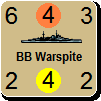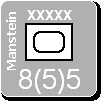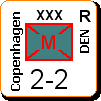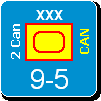warspite1
Posts: 41353
Joined: 2/2/2008
From: England
Status: offline

|
Next US carrier class with a completed write-up is the Yorktown-class. Please see the Yorktown herself which feature the Battle of Midway.
[4056 Yorktown - by Robert Jenkins]
.B Engine(s) output: 120,000 hp
.B Top Speed: 32.5 knots
.B Main armament: 8 x 5-inch (127mm), 16 x 1.1-inch (28mm) guns
.B Aircraft: 90 (Operational Maximum 81)
.B Displacement (full load): 25,484 tons
.B Thickest armour: 4-inch (belt)
.P The three ships of the Yorktown-class were the first of the modern United
States Navy (USN) carriers; the previous four having been a mixture of the
experimental Langley, two battlecruiser conversions and the disappointing USS
Ranger. The first two ships were built between 1934 and 1938, while the third
ship, Hornet, was built between 1939 and 1941, as a counter to the Japanese
refusal to abide by the 1936 London Naval Treaty.
.P The Washington Naval Treaty of 1922 had allowed the USN an allowance of 69,000
tons for the purposes of building new carriers. After the disappointing
performance of USS Ranger, two larger carriers of the Yorktown-class were
constructed. It was hoped that this design would provide a better balance between
the size of the ship, its protection and the air group that could be carried. In
Yorktown and Enterprise, the USN achieved this, and these ships influenced the
design of the subsequent Essex-class.
.P These carriers could carry around ninety aircraft, although operationally the
optimal number was around eighty. The ships had two hangars, served by three
lifts. Three catapults were fitted, designed to launch 5,500lb aircraft at 40
knots. Two were fitted on the flight-deck forward, while a third was fitted at
hangar deck level, but this was rarely used. Nine arrester wires were provided to
assist landing.
.P The Yorktowns armour protection consisted of a belt, 4-inches thick at its
maximum, that gave horizontal protection to the machinery spaces, magazines and
aviation fuel. Underwater, anti-torpedo protection was provided by a layer of
three tanks that were designed to cushion the impact of any torpedo. The outer
two tanks were filled with liquid, while the middle one was filled with air.
Vertical protection was limited to a 1.5-inch armour deck.
.P Defensive armament was provided by eight 5-inch dual-purpose guns which gave
these ships excellent anti-aircraft (AA) defence. For close-range defence, four
quadruple 1.1-inch guns were fitted.
.P Most USN aircraft carriers have been named after famous battles or famous
Americans. Yorktown was named after one of the most decisive battles of the
American War of Independence, fought and won by a combined Franco-American force
against the British in 1781.
.P Yorktown was completed in September 1937. She was in Norfolk, Virginia in
December 1941 when the Japanese attacked the naval base at Pearl Harbor, but was
quickly despatched through the Panama Canal to join the Pacific Fleet after the losses
suffered in that attack (see USS Arizona). Yorktown arrived in San Diego at the end of
December, whereupon she became the Flagship of Task Force (TF) 17 under the
command of Rear-Admiral Fletcher. In the immediate aftermath of Pearl Harbor
TF17 was one of three task forces, each built around a carrier, that would seek
to take the war to the Japanese.
.P Her first operation began at the start of January 1942, escorting a convoy
taking the 2nd Marine Brigade to Pago Pago in Samoa. She was joined in TF17 by
the cruisers Louisville and St Louis and their escorting destroyers.
.P From Samoa, TF17 then joined up with Vice-Admiral Halsey`s TF8 in order to
undertake air strikes against the Japanese held islands in the Marshalls and the
Gilberts (see USS Salt Lake City). These strikes, carried out at the beginning of
February, caused only slight damage to the Japanese, but they were carried out in
order to show the Japanese that the losses at Pearl Harbor would not stop the US
from fighting back at every opportunity; they were also seen as a way of boosting
morale and providing valuable combat experience for the men of the USN. A further
strike against Eniwetok a couple of weeks later was cancelled as TF17 were needed
to provide escort for convoys taking reinforcements to the south-west Pacific.
.P Upon arrival in that region, TF17 joined with TF11, containing the carrier
Lexington and together, they were tasked with launching an air strike against
Japanese positions in northern New Guinea. The air strikes were carried out from
a position south of the island and was successful in sinking or destroying a
number of Japanese ships, including the cruiser Yubari which was damaged.
.P At the start of May, TF17 and TF11 were merged to form an enlarged TF17 under
Fletcher and this force was stationed in the Coral Sea. This was in response to
US intelligence finding out that the Japanese intended to invade Port Moresby in
the south of New Guinea as well as Tulagi in the Solomons. The battle that ensued
became known as the Battle of the Coral Sea, during which Japanese expansion
plans were checked for the first time (see USS Lexington). Yorktown took a bomb
hit that did serious damage and would have ordinarily kept her from taking any
part in combat operations for many weeks to come. However, the USN did not have
the luxury of time as the Japanese were planning their next operation for the
start of June. Thanks to a super-human effort, Yorktown was patched up and was
thrown into her next, and last operation; the Battle of Midway.
.P Midway was to be the most decisive naval battle since Trafalgar, 137 years
previously, but sadly Yorktown was not to survive the engagement. The battle was
fought as an indirect result of the Doolittle raid the previous April (see USS
Hornet). This attack had convinced the Japanese of the need to push their
defensive perimeter even further east and to quickly destroy the US carriers they
had missed at Pearl Harbor. Although Admiral Yamamoto had the Midway operation in
mind before the Doolittle Raid, he had failed to win sufficient support for the
operation; the bombing of Tokyo won the argument in his favour.
.P The Japanese plan was to attack Midway using aircraft from their 1st Air Fleet
which would neutralise the island`s air defences. The Japanese would then be free
to invade Midway, forcing the Americans to bring their carriers into battle to
defend the island; at which point they would be sunk. Simple. However, a number
of factors combined to ensure that what happened, was very different from what
the Japanese had planned for. Firstly, the plan was overly complex, calling for
diversionary landings in the Aleutians that achieved nothing save dispersing the
Japanese forces; secondly, damage done to the carrier Shokaku, and her sister
Zuikaku`s loss of aircraft at the Battle of the Coral Sea had cost Yamamoto two
of his six fleet carriers; thirdly, the "victory disease" that the Japanese had
exhibited during the Coral Sea encounter remained on display at Midway. This
evidenced itself in massive over confidence and a complete certainty that the
USN would react exactly as Yamamoto expected them to. That the USN may have
advance warning of the Japanese plan, was not considered; even in the face of
evidence to the contrary.
.P The Japanese forces were split into a dozen groups, five of which were
assigned to the Aleutian operation. For Midway - Operation Mi - the First Carrier
Striking Force would lead the attack. This force, under Vice-Admiral Nagumo,
consisted of the fleet carriers Akagi, Kaga, Soryu and Hiryu; the battleships
Haruna and Kirishima; the cruisers Tone and Chikuma and a screening force led by
the cruiser Nagara with three destroyer flotillas. The remaining forces were to
play little part in the events to come.
.P Prior to the launch of the Japanese operation, an American intelligence unit
based at Hawaii, and led by Commander Joseph Rochefort, had correctly worked out
the Japanese target. This allowed Admiral Nimitz to bring his three remaining
carriers back to Pearl Harbor to await the Japanese attack. Thanks to the
incredible turnaround of Yorktown, Nimitz was able to deploy all three carriers.
These ships were split into two task forces, under the command of Fletcher. TF17
consisted of Yorktown, the heavy cruisers Astoria and Portland and six
destroyers. TF 16 was commanded by Rear-Admiral Raymond Spruance, who was
promoted to the role due to the ill-health of Vice-Admiral Halsey. This was to be
Spruance`s first such command, and the faith shown in him was to be amply repaid.
TF16 was made up of the carriers Enterprise and Hornet; the heavy cruisers
Minneapolis, New Orleans, Northampton, Pensacola and Vincennes; the light cruiser
Atlanta and nine destroyers.
.P Spruance sailed on the 28th May for the rendezvous point, which was 325 miles
north-east of Midway; Point Luck. Fletcher followed the following day and the two
task forces met up on the 2nd June. The plan was that the aircraft on Midway,
approximately one hundred and fifteen aircraft, would be used in the following
way; the long range Catalina aircraft would search for the enemy carriers and
once found, the bombers would be used to attack them, escorted by the fighters.
In addition, the carrier planes would also be used to attack Nagumo`s carriers;
on Midway it would be left to the AA defences alone to defend itself.
.P The Japanese forces had sailed from their various bases in the last week of
May, the First Carrier Strike Force left Japan on the 27th. Essentially, the
Japanese forces were split in two, sailing parallel with each other toward their
target. To the north were Nagumo`s carriers and Yamamoto`s 1st Fleet Main Body,
which contained his Flagship, the giant battleship Yamato. To the south were the
Midway Invasion Force, the 2nd Fleet Main Body and the Midway Support Force.
.P On the 3rd June, about six hundred miles from Midway, contact was made when a
Catalina spotted what turned out to be the Midway Invasion Force. Two attacks
were launched from Midway despite the long range. Firstly, a flight of nine B-17
bombers carried out a high level attack, but failed to deliver any bombs on
target. Secondly, in the early hours of the 4th June, four Catalina`s launched
torpedoes against the enemy transports and one of these hit and damaged the
transport Akebono Maru, although she was able to continue with the convoy.
.P The knowledge that the Invasion Fleet had been spotted much earlier than
planned did not cause the Japanese to alter their plan of action; in fact Nagumo
was not even made aware of this development, while on the American side, Nimitz
was not tempted to send his carriers or their aircraft south to meet this threat;
he still firmly believed his intelligence, and that Nagumo`s carriers would
appear to the north-west of Midway, from where they would launch their air
assault on the island. That night, Nimitz ordered his carriers to sail from Point
Luck to a position two hundred miles north of Midway; the 4th June would be a
busy day.
.P The Japanese carriers were in position to begin their attack in the early
hours of the 4th. At 0430hrs the first of one hundred and eight aircraft took off
from the four carriers. At around this time the Japanese also launched their
reconnaissance flights. Once again though, the Japanese plan was tardy in both
its design, and its execution. The reconnaissance forces allocated to the task
were insufficient, too limited in scope and, when problems were encountered with
some of the aircraft, there was no back-up plan. The USN may have had the
advantage given to them by Rochefort`s intelligence unit that confirmed roughly
where the Japanese would appear, but it was the actions of the officers and men
of the Imperial Japanese Navy that sowed the seeds of their defeat.
.P From Midway that morning, long-range reconnaissance aircraft were sent into
the sky to begin their search for Nagumo`s carriers, while the aircraft of the
First Wave, closed in on the island. The carriers were found by a Catalina at
around 0520hrs and shortly after, another Catalina spotted the in-bound strike
aircraft. Contrary to Nimitz`s orders, some of the fighter aircraft remained at
Midway to attack the attacking aircraft, although they were soon to lose out in
the dogfights that developed and the bombers were left largely intact to attack
targets on the ground. With no aircraft on the ground to destroy, this first
attack was only partially successful and it was clear that a further strike would
be required to neutralise Midway`s defences.
.P Meanwhile, aboard the US carriers, Fletcher had decisions to make. He decided
to order Spruance, with Enterprise and Hornet, to close the gap to the Japanese
carriers as he desperately wanted to attack them when they were at their most
vulnerable - between the recovery of the First Wave and the launching of the
second. Spruance kept thirty-six fighters to guard his carriers and the remaining
one hundred and twenty-one aircraft began taking-off from 0700hrs and flew to
seek out the enemy. An hour and a half later Yorktown, sailing behind TF16 as she
had to recover her scout planes that had been sent out that morning, launched
thirty-five of her aircraft too.
.P With his First Wave in the air, Nagumo ordered the Second Wave to be prepared.
This strike force would include torpedo armed "Kate" aircraft to sink the USN
carriers. There was just one problem; the Japanese had not spotted the carriers,
and Nagumo was probably convinced there were none in the area. Then at 0700hrs,
the commander of the First Wave, Lt Tomonaga, radioed Nagumo to request a second
strike against Midway. Nagumo agreed and ordered that the Kates have their
torpedoes swapped for bombs.
.P At around this time, the first of the Midway based aircraft had reached the
Japanese carriers. Four B-26 Marauders and six TBF`s (later to be named Avengers
as a result of this action) attacked Akagi, but scored no hits for the loss of
seven aircraft. Just before 0800hrs another group of aircraft from Midway arrived
on the scene. First to attack were sixteen Dauntless dive-bombers that attacked
the Hiryu, but again no hits were scored and half the aircraft were shot down.
This attack was followed by the arrival of a flight of B-17s that had originally
been ordered to attack the invasion convoy, but had been diverted north once the
carriers had been spotted. As had happened the day before however, the high level
attacks proved fruitless. The final attack from Midway was launched by obsolete
Vindicator aircraft with predictable results.
.P Having survived all that the American airmen could throw at him, at 0830hrs
Nagumo could be forgiven for feeling invincible. If he did, that feeling was to
last only a short time. Picture the scene: the First Wave had returned to their
carriers and were waiting to land; the Second Wave was on-deck, armed with bombs
waiting for the order to launch against Midway...and now, to his horror, came
news that could not have been more threatening. One of the scout planes had
spotted an American carrier.
.P Nagumo, not unreasonably, did not want to launch his bombers against the enemy
carrier as they had no fighter escort ready. The decision he took was for the
aircraft of the second wave to be taken below, have the bombs on board the Kates
replaced with torpedoes, and allow the First Wave to land. At just after 0900hrs
all aircraft of the First Wave had been recovered. Now was the time for the
Japanese to head for where the American carrier had been sighted in order to send
her to the bottom of the Pacific.
.P After the carriers changed course, so the first of the one hundred and fifty-
six US carrier planes, launched earlier, came into view of the look-out on board
Chikuma. Not all the aircraft had found the Japanese however; caught out by their
previous change of course. The Dauntless and Wildcat crews from Hornet fell
victim to this mistake and while the longer range dive-bombers mostly made it
back to Midway or Hornet, the fighters had to ditch. Lt-Cdr Waldron, also from
Hornet, guessed correctly that the Japanese would change course and his squadron
of fifteen Devastator aircraft came upon the enemy at 0920hrs. Bravely, without
fighter cover, he led his men, in their out-dated aircraft toward the carriers.
Waldron and his men had no chance and they were blown out of the sky by a
combination of Zero fighters and AA hits before even getting close to Akagi.
There was just one survivor.
.P Next on the scene were fourteen Devastators from Enterprise. Just four managed
to make it back to their carrier and their attack on Hiryu achieved not one hit.
Another Devastator attack, this time from Yorktown, cost ten out of twelve
aircraft. Things were going badly for the American airmen; but events were about
to change rather dramatically.
.P At 1020hrs, the next aircraft to arrive were Dauntless dive-bombers from
Enterprise and Yorktown. The sacrifice of the torpedo bomber crews was not to be
in vain as although they had not achieved hits on the Japanese carriers, they had
pulled the Zero fighter cover out of position. As a result, there was little to
stop the dive-bombers that were about to fall on the carriers. The first target
was Kaga. The thinly armoured Japanese carriers were vulnerable to bombs at the
best of times, but with fully armed and fuelled aircraft on their deck ready to
take-off, they only needed a single hit to turn them into fireballs.
.P Kaga was hit no less than four times and she was almost immediately on fire
the full length of the ship. It would take until the early evening for her to
slip beneath the waves, but she had been put out of action when the first bomb
had landed on her crowded flight-deck. Nagumo`s Flagship suffered a similar fate
as two bombs tore into Akagi`s aircraft awaiting take-off. One of these bombs
caused the aft lift to collapse onto the hangar deck, causing further explosions
amongst the Second Wave aircraft there being readied for launch. Nagumo survived
and transferred to the light cruiser Nagara, but his thoughts at that moment can
only be imagined. His Flagship was scuttled early the next morning by torpedoes
from a destroyer. The story on Soryu was much the same; three bombs, huge fires,
and a ship that finally sank only in the early evening, having been abandoned
many hours before.
.P One of the fleet carriers had managed to avoid the carnage, and aircraft from
Hiryu were launched at 1100hrs to attack the Yorktown which had remained under
surveillance since the initial sighting. Eighteen "Val" dive-bombers were sent to
attack with an escort of six Zeros. Although Yorktown was able to counter with a
large number of fighters and a heavy AA barrage, five aircraft got through; three
of whom hit their target. The superb damage control parties did their job, and
soon the carrier was patched up. The Japanese launched a second strike soon
after, although they could muster only ten "Kate" torpedo bombers and six more
Zeros. Once more, five survivors from the AA and fighter screen got through to
Yorktown. Lt Tomonaga crashed his aircraft onto the flight-deck and two torpedoes
found the port side of the American carrier. But still the Yorktown would not
die. She had been abandoned after the second strike, but by the next morning it
was thought she could be saved. Despite two torpedoes and four bombs (including
one at the Coral Sea), the Japanese naval air arm had not been able to sink this
remarkably defiant ship. Sadly however, her fate was to be sunk; albeit at the
hands of a Japanese submarine rather than the Japanese naval air arm.
.P I-168 had been one of the submarines ineffectively deployed off Midway Island,
but she was now ordered to destroy Yorktown. At 1300hrs on the 6th June, she
launched four torpedoes, hitting the damaged carrier with two, while a third slammed
into the destroyer Hamman that was moored next to the carrier, assisting with the
salvage work. The destroyer sank immediately, but even with two more torpedoes
having hit her, Yorktown only finally sank in the early morning of the 7th June!
.P Yorktown had at least managed to outlive Nagumo`s last remaining fleet
carrier. Hiryu sank at 0820hrs on the 5th June having been found the previous
afternoon by US aircraft. At just after 1700hrs, she was attacked by aircraft
from both Enterprise and Hornet and four bombs, all dropped by Dauntless dive-
bombers, slammed into the remaining carrier. With Hiryu gone, Yamamoto`s last
hope of salvaging something from the Midway operation had disappeared. For Japan,
the war was now quite simply un-winnable...if indeed it ever had been otherwise.
< Message edited by warspite1 -- 11/28/2009 4:18:36 PM >
_____________________________
England expects that every man will do his duty. Horatio Nelson October 1805  |
 Printable Version
Printable Version





















 - thanks Froonp
- thanks Froonp 
 New Messages
New Messages No New Messages
No New Messages Hot Topic w/ New Messages
Hot Topic w/ New Messages Hot Topic w/o New Messages
Hot Topic w/o New Messages Locked w/ New Messages
Locked w/ New Messages Locked w/o New Messages
Locked w/o New Messages Post New Thread
Post New Thread